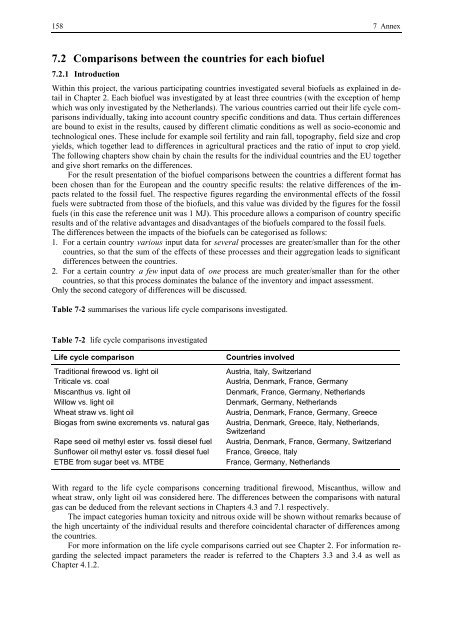BIOENERGY FOR EUROPE: WHICH ONES FIT BEST?
BIOENERGY FOR EUROPE: WHICH ONES FIT BEST?
BIOENERGY FOR EUROPE: WHICH ONES FIT BEST?
You also want an ePaper? Increase the reach of your titles
YUMPU automatically turns print PDFs into web optimized ePapers that Google loves.
158 7 Annex<br />
7.2 Comparisons between the countries for each biofuel<br />
7.2.1 Introduction<br />
Within this project, the various participating countries investigated several biofuels as explained in detail<br />
in Chapter 2. Each biofuel was investigated by at least three countries (with the exception of hemp<br />
which was only investigated by the Netherlands). The various countries carried out their life cycle comparisons<br />
individually, taking into account country specific conditions and data. Thus certain differences<br />
are bound to exist in the results, caused by different climatic conditions as well as socio-economic and<br />
technological ones. These include for example soil fertility and rain fall, topography, field size and crop<br />
yields, which together lead to differences in agricultural practices and the ratio of input to crop yield.<br />
The following chapters show chain by chain the results for the individual countries and the EU together<br />
and give short remarks on the differences.<br />
For the result presentation of the biofuel comparisons between the countries a different format has<br />
been chosen than for the European and the country specific results: the relative differences of the impacts<br />
related to the fossil fuel. The respective figures regarding the environmental effects of the fossil<br />
fuels were subtracted from those of the biofuels, and this value was divided by the figures for the fossil<br />
fuels (in this case the reference unit was 1 MJ). This procedure allows a comparison of country specific<br />
results and of the relative advantages and disadvantages of the biofuels compared to the fossil fuels.<br />
The differences between the impacts of the biofuels can be categorised as follows:<br />
1. For a certain country various input data for several processes are greater/smaller than for the other<br />
countries, so that the sum of the effects of these processes and their aggregation leads to significant<br />
differences between the countries.<br />
2. For a certain country a few input data of one process are much greater/smaller than for the other<br />
countries, so that this process dominates the balance of the inventory and impact assessment.<br />
Only the second category of differences will be discussed.<br />
Table 7-2 summarises the various life cycle comparisons investigated.<br />
Table 7-2 life cycle comparisons investigated<br />
Life cycle comparison Countries involved<br />
Traditional firewood vs. light oil Austria, Italy, Switzerland<br />
Triticale vs. coal Austria, Denmark, France, Germany<br />
Miscanthus vs. light oil Denmark, France, Germany, Netherlands<br />
Willow vs. light oil Denmark, Germany, Netherlands<br />
Wheat straw vs. light oil Austria, Denmark, France, Germany, Greece<br />
Biogas from swine excrements vs. natural gas Austria, Denmark, Greece, Italy, Netherlands,<br />
Switzerland<br />
Rape seed oil methyl ester vs. fossil diesel fuel Austria, Denmark, France, Germany, Switzerland<br />
Sunflower oil methyl ester vs. fossil diesel fuel France, Greece, Italy<br />
ETBE from sugar beet vs. MTBE France, Germany, Netherlands<br />
With regard to the life cycle comparisons concerning traditional firewood, Miscanthus, willow and<br />
wheat straw, only light oil was considered here. The differences between the comparisons with natural<br />
gas can be deduced from the relevant sections in Chapters 4.3 and 7.1 respectively.<br />
The impact categories human toxicity and nitrous oxide will be shown without remarks because of<br />
the high uncertainty of the individual results and therefore coincidental character of differences among<br />
the countries.<br />
For more information on the life cycle comparisons carried out see Chapter 2. For information regarding<br />
the selected impact parameters the reader is referred to the Chapters 3.3 and 3.4 as well as<br />
Chapter 4.1.2.

















